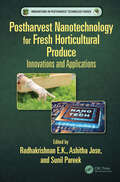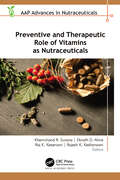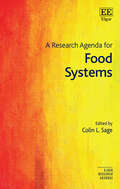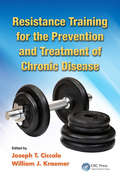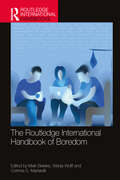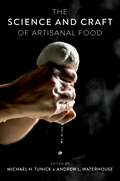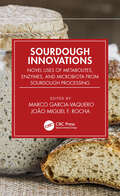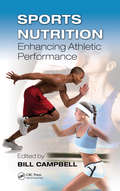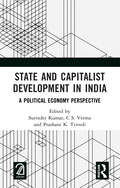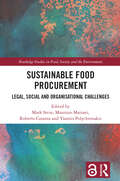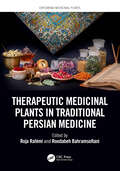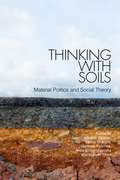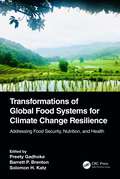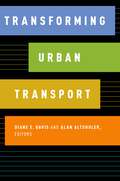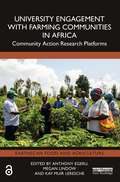- Table View
- List View
Postharvest Nanotechnology for Fresh Horticultural Produce: Innovations and Applications (Innovations in Postharvest Technology Series)
Food scarcity and insecurity is an alarming issue throughout the world. Postharvest loss due to both mechanical damage and microbial spoilage significantly influences the shelf life and hence the availability of agricultural produce. Once initiated, the microbial spoilage can make bulk quantity of a given agricultural product unacceptable for human consumption, and several methods have already been used to try to manage this. Considering the limited success of the available methods, there is increasing interest in exploring nanotechnological methods. These methods are being considered for both the development of various platforms for antimicrobial/barrier packaging applications that minimize the contact of agricultural produce with the external environment, and also for design sensors to ensure food safety and quality. The impact of various nano-systems developed through material engineering on the shelf-life enhancement and storage of fresh horticultural produce will have revolutionary effects on post-harvest management in the coming years. Hence, Postharvest Nanotechnology for Fresh Horticultural Produce has been edited to advance understanding of material development, intelligent selection of nanomaterials to ensure the nontoxic nature, and future perspectives of nanotechnology on postharvest produce. This includes various types of nanoparticles exploited for the postharvest management, their mechanism of action, varied applications and material engineering, along with natural products including essential oils and plant bioactives, modelling of various tailor-made materials to meet the required properties of the packed food, advancements in the nanotechnological applications for the minimally processed food, and the toxicity concerns. Key Features: · Describes advances in nanotechnology for postharvest management · Includes extensive details on the applications of material engineering for post-harvest applications using nanotechnology and future aspects · Provides extensive data on the types of nanomaterials used and the fabrication methods employed for the design of tailor-made products for the post-harvest management This book reviews the current scientific advancements and future prospects of the nanotechnological interventions in meeting the quality and quantity standards of the horticultural produce and minimally processed food and will be a valuable reference for beginners, researchers, subject experts, and industrialists.
Preventive and Therapeutic Role of Vitamins as Nutraceuticals (AAP Advances in Nutraceuticals)
This new book provides informative coverage of recent breakthroughs in vitamins and their ability to prevent disease, manage health issues, and treat chronic illness. It describes the beneficial effects of vitamins as nutraceuticals in treating cancer, for improving the immunity of patients with HIV and AIDS, for the treatment of tuberculosis, and for the management of infectious diseases, such as viral infections, microbial infections, and COVID-19. The functional activity of vitamins in brain health and obesity management is also explored for the management, prevention, and delay of hypertension and related problems. The volume also covers vitamins that play a role in neurodegenerative diseases as well as those that can be used for weight loss and obesity, blindness and vision issues, baldness, and skincare issues.
A Research Agenda for Food Systems (Elgar Research Agendas)
Elgar Research Agendas outline the future of research in a given area. Leading scholars are given the space to explore their subject in provocative ways, and map out the potential directions of travel. They are relevant but also visionary.Illuminating the global food system as a highly dynamic set of interconnecting interests and sub-systems that drives rapid technological, societal, and cultural change, this cutting-edge Research Agenda examines the pressing issues that confront food systems, and the emerging responses to them.Chapters from internationally renowned specialists address the pressing issues facing food systems, including the growing concentration and power of large agri-food corporations, the contribution of food production to climate breakdown, the exploitation of agricultural labour, food poverty, and the reconfiguration of animal bodies. Reviewing possible ‘solutions’ chapters then examine the potential for a digital agricultural revolution, the contribution of alternative proteins in dietary change, and the emergence of regionalized and regenerative food systems. The book concludes with a look towards hybrid foodscapes, exploring how design can help us to re-imagine our stake in food systems of the future. Interdisciplinary, holistic, and accessible in its approach, this innovative book will prove vital to students and scholars engaged in the study of food – from production to consumption – as well as those concerned with policymaking in the fields of public health and nutrition, food governance, sustainability, and environmental advocacy.
Resistance Training for the Prevention and Treatment of Chronic Disease
Current evidence supports the use of resistance training as an independent method to prevent, treat, and potentially reverse the impact of numerous chronic diseases. With physical inactivity one of the top risk factors for global mortality, a variety of worldwide initiatives have been launched, and resistance training is promoted by numerous organi
The Routledge International Handbook of Boredom (Routledge International Handbooks)
This comprehensive text is a unique handbook dedicated to research on boredom. The book brings together leading contributors from across three continents and numerous fields to provide an interdisciplinary exploration of boredom, its theoretical underpinnings, its experiential properties, and the applied contexts in which it occurs.Boredom is often viewed as a mental state with little utility, though recent research suggests that it can be a powerful motivator of human behavior that shapes our actions in many ways. The book examines boredom from a range of perspectives and is comprised of three parts. Part I delves into the theoretical approaches to boredom, presenting methods for its measurement, explaining when and why boredom occurs, and scrutinizing the impact it has on our behavior. Part II focuses on the psychological and neural properties of boredom and its associations with a multitude of mental and interpersonal processes, such as self-control, mind-wandering, flow, and aggression. Part III presents boredom in practical contexts like school and work, and sheds light on its role for health-related behaviors, psychosocial well-being, and aesthetic experiences. The book concludes by summarizing the state of boredom research, identifying promising areas for future research, and providing directions for how research on boredom can be advanced. As the authoritative book on boredom, this handbook is an essential resource for students and researchers of psychology, sociology, education, sport science, and computer science.
The Science and Craft of Artisanal Food
You are what you eat, and today's consumers care about the origins of their food. Artisanal food embodies those concerns, tailoring processes to raw materials to achieve the artisan's vision of the perfect product. The Science and Craft of Artisanal Food describes the science behind small and large-scale production of food, distinguishing artisanal production from normal commercial practice. Each chapter is written in a collaboration between scientists and artisans, comparing the production methods used to create beer, wine, chocolate, coffee, cheese, honey, olive oil, and fruits and vegetables. These expert contributors highlight the differences in practices that cause artisanal food to vary in composition, flavor, and texture from mass-produced food. Milk from particular breeds, grapes adapted to the local climate, olives and cacao from a historically important cultivar, or coffee beans from a specific climate can make all the difference. This book reveals the factors that make a difference in each product, and teaches readers how to assess the producer's messages to evaluate their authenticity.
Sourdough Innovations: Novel Uses of Metabolites, Enzymes, and Microbiota from Sourdough Processing
Sourdough fermentation was probably one of the first microbial processes employed by mankind for the production and preservation of food. This practice is still widely used worldwide due to the distinct sensorial and health properties attributed to these products. Traditional sourdough bread is achieved by spontaneous fermentations, leading to natural selections of microorganisms (mainly yeast and lactic acid bacteria) with health benefits for the consumers’ microbiota. However, multiple opportunities are currently underexploited through the entire sourdough value chain. Sourdough Innovations: Novel Uses of Metabolites, Enzymes, and Microbiota from Sourdough Processing summarizes the latest scientific knowledge and current opportunities of sourdough technology at biomass, microbiota and enzymatic levels described in three distinctive sections. Section I covers the fermentation process of cereals and non-cereals to produce sourdough-containing compounds with health-enhancement benefits. Section II includes novel advances in sourdough enzymology, and last, Section III explores various applications of sourdough microbiota as antimicrobial and probiotic microorganisms and opportunities to be included in both food and non-food applications. Key Features: Includes extensive information on the use of innovative or emerging technologies aiming to promote circular exploitation systems. Promotes the full use of the cereal and non-cereal sourdough metabolites. Covers the functionality of sourdough microorganisms and functional compounds, and future exploitation of some of them in the field of nutraceuticals or functional foods. Sourdough Innovations is unique in its examination of health beneficial compounds through the downstream processing of sourdough from cereals, microbiota, and enzymes. It is a great source for academic staff and scientists within the broad area of food science who are researching, lecturing, or developing their professional careers in food microbiology, food chemistry, food processing, and food technology, including bio-process engineers interested in the development of novel technological improvements in sourdough processing.
Sports Nutrition: Enhancing Athletic Performance
With the constant flow of information related to sports nutrition coming from scholarly journals, it is difficult to sift through it all and determine what is relevant. Sports Nutrition: Enhancing Athletic Performance helps in this endeavor, with more than 1,000 references from top academic journals, offering critical knowledge concerning nutrient
Star Fruit (Cross-Section) (Large Print)
This is a labelled image of a star fruit (also known as a carambola) shown in horizontal cross section (cut through from side to side). There is a locator dot shown, which will be at the top left of the page when the image is the correct way up. The star fruit is shown in centre of the page; it is a long fruit, and has three to six ridges (usually five) running down its sides. These ridges give the fruit a star-like shape in cross section. There are five seeds in the centre of the image; their arrangement matches that of the ridges on the fruit. The star fruit is usually about ten centimetres long. Its flesh and skin are a light yellowy green and can be tinged with orange when very ripe.
Star Fruit (Cross-Section) (UEB Contracted)
This is a labelled image of a star fruit (also known as a carambola) shown in horizontal cross section (cut through from side to side). There is a locator dot shown, which will be at the top left of the page when the image is the correct way up. The star fruit is shown in centre of the page; it is a long fruit, and has three to six ridges (usually five) running down its sides. These ridges give the fruit a star-like shape in cross section. There are five seeds in the centre of the image; their arrangement matches that of the ridges on the fruit. The star fruit is usually about ten centimetres long. Its flesh and skin are a light yellowy green and can be tinged with orange when very ripe.
Star Fruit (Cross-Section) (UEB Uncontracted)
This is a labelled image of a star fruit (also known as a carambola) shown in horizontal cross section (cut through from side to side). There is a locator dot shown, which will be at the top left of the page when the image is the correct way up. The star fruit is shown in centre of the page; it is a long fruit, and has three to six ridges (usually five) running down its sides. These ridges give the fruit a star-like shape in cross section. There are five seeds in the centre of the image; their arrangement matches that of the ridges on the fruit. The star fruit is usually about ten centimetres long. Its flesh and skin are a light yellowy green and can be tinged with orange when very ripe.
State and Capitalist Development in India: A Political Economy Perspective
This book seeks to encourage dialectical methods through the interaction of economic, political and social factors to approach social analysis. It examines various emerging issues in society in the era of globalization. The issues raised in the critique will benefit scholars in comprehending social reality with a new perspective and approach. This book will help policymakers look at more realistic conclusions for policy making. This title is co-published with Aakar Books. Print editions not for sale in South Asia (India, Sri Lanka, Nepal, Bangladesh, Pakistan and Bhutan)
Sustainable and Functional Foods from Plants: Health Impact, Bioactive Compounds, and Production Technologies (Innovations in Agricultural & Biological Engineering)
Structured into four main parts, this book navigates the intersection between food and functionality of plant-based products and provides insight into the nutritional composition of some key elements of plant-based diets. The book also introduces the most abundant adulteration practices and points out the analytical methods of quality monitoring, their current trends, and their potential future applications.The volume first looks at plant-based sustainable health foods, with a primary focus on millets, their nutritional and health benefits, as well as their potential as food security crops. The chapters also shed some light on demographics of millet production and discuss the impact of processing on the nutritional and organoleptic attributes of millet-based products. New advances in production, quality determination, and functional health benefits of two globally renowned beverages—wine and beer—are discussed while mapping consumption trends and consumers’ expectations and preferences.Sustainable and Functional Foods from Plants also explores some ethnic foodstuffs, ingredients, and condiments of functional importance for the cuisines of African, European, and Far Eastern countries, and then looks at the potential of bioactive compounds in medicinal foods and measurement techniques for quality of natural foods.The book will be informative for upper-level students as well as for food science teaching staff, researchers, and industrial personnel interested in theoretical and practical knowledge about sustainable and functional foods from plants.
Sustainable Food Procurement: Legal, Social and Organisational Challenges (Routledge Studies in Food, Society and the Environment)
The book examines sustainable food procurement policy and practice in the European Union and beyond, exploring the extent to which sustainability objectives have been achieved and evaluating the new developments taking place at both EU and national levels.While there is a growing recognition that public authorities can use public procurement as a policy tool to pursue multiple environmental, health and socio-economic objectives, contracting authorities still face many challenges. This volume investigates the scope for pursuing sustainable objectives in public procurement of food and catering services, examining different regulatory contexts and organisational models to answer the overall question of how to integrate sustainability concerns into the various phases of public food procurement processes. Contributions in the book examine the policy and legal procurement framework and practices for sustainable public catering in three EU Member States: Italy, France and Spain. There is a comparative survey of the Baltic Region, including Denmark, Estonia, Finland, Poland and Russia, and moving beyond the EU, there is examination of the UK and Brazil, as well as a cross country comparison of the UK with Denmark and Sweden. Drawing on the expertise of an interdisciplinary and intersectoral team of contributors allows the book to benefit from the insights of different disciplines, including business sciences, anthropology and law. Tapping into the global discussion on public food procurement as a means to achieve multiple social and environmental goals, this work will stimulate readers looking for new creative ways to create value through public food purchasing.This book will be of great interest to students, researchers, policymakers and public- and private-sector representatives interested in public procurement, food policy and law, sustainable food sourcing and supply chain management.
Sweets (Large Print)
There is an image of three sweets on this page: a lollipop and two more sweets wrapped in coloured paper. There is a locator dot shown, which will be at the top left of the page when the image is the correct way up. The yellow lollipop is on the left side of the page, near the top. It has the round sweet bit at the top with a red spiral decoration on it, and down from this is its long stick. There is another sweet to the right of the lollipop. It has its violet paper wrapping twisted up to the left and right. In the bottom centre of the page is the third sweet. It is round, and like the one up the page it has its red and pink paper wrapping twisted up to either side.
Therapeutic Medicinal Plants in Traditional Persian Medicine (Exploring Medicinal Plants)
Traditional Persian Medicine (TPM) is one of the oldest medical doctrines, globally known due to pioneering physicians and scientists. The greatest source of natural medicines in TPM originates from medicinal plants. Therapeutic Medicinal Plants in Traditional Persian Medicine provides a background on the history of TPM, as well as an introduction to 40 of the most popular medicinal plants used in TPM. It is a practical guide for readers interested in medicinal plants used in the prevention, management, and treatment of different diseases.Features: Includes both traditional therapeutic applications and modern evidence/ uses Makes a comparison between preclinical and clinical studies Provides information on major chemical constituents, therapeutic uses, adverse reactions, and safety for each plant species A volume in the “Exploring Medicinal Plants” series, this book is a valuable resource for researchers, students, academicians, and scientists dealing witth medicinal plants, as well as for those interested in the fields of pharmacognosy, naturopathy, phytotherapy, and traditional medicines.
Thinking with Soils: Material Politics and Social Theory
This book presents a novel and systematic social theory of soil, and is representative of the rising interest in 'the material' in social sciences. Bringing together new modes of 'critical description' with speculative practices and methods of inquiry, it contributes to the exploration of current transformations in socioecologies, as well as in political and artistic practices, in order to address global ecological change.The chapters in this edited volume challenge scholars to attend more carefully to the ways in which they think about soil, both materially and theoretically. Contributors address a range of topics, including new ways of thinking about the politics of caring for soils; the ecological and symbiotic relations between soils; how the productive capacities and contested governance of soils are deployed as matters of political concern; and indigenous ways of knowing and being with soil.
Tomato (Cross Section) (Large Print)
This is a labelled image of a tomato shown in longitudinal cross section (cut through from top to bottom). There is a locator dot shown, which will be at the top left of the page when the image is the correct way up. The image of the tomato is in the middle of the page.v At its centre is the fruis core and this is surrounded by seeds in the locular cavities. They have a gelatinous covering and are attached to the core by jelly-like threads. On the outside of the fruit are its flesh and skin. At the top of the image is the stem of the tomato with a leaf to the left and right. Tomatoes vary in size between the cherry tomato at about two centimetres to monsters of twelve centimetres, weighing up to three kilos. Although usually a bright red, tomatoes range in colour from a deep red through orange to pale yellow.
Tomato (Cross Section) (UEB Contracted)
This is a labelled image of a tomato shown in longitudinal cross section (cut through from top to bottom). There is a locator dot shown, which will be at the top left of the page when the image is the correct way up. The image of the tomato is in the middle of the page.v At its centre is the fruis core and this is surrounded by seeds in the locular cavities. They have a gelatinous covering and are attached to the core by jelly-like threads. On the outside of the fruit are its flesh and skin. At the top of the image is the stem of the tomato with a leaf to the left and right. Tomatoes vary in size between the cherry tomato at about two centimetres to monsters of twelve centimetres, weighing up to three kilos. Although usually a bright red, tomatoes range in colour from a deep red through orange to pale yellow.
Tomato (Cross Section) (UEB Uncontracted)
This is a labelled image of a tomato shown in longitudinal cross section (cut through from top to bottom). There is a locator dot shown, which will be at the top left of the page when the image is the correct way up. The image of the tomato is in the middle of the page.v At its centre is the fruis core and this is surrounded by seeds in the locular cavities. They have a gelatinous covering and are attached to the core by jelly-like threads. On the outside of the fruit are its flesh and skin. At the top of the image is the stem of the tomato with a leaf to the left and right. Tomatoes vary in size between the cherry tomato at about two centimetres to monsters of twelve centimetres, weighing up to three kilos. Although usually a bright red, tomatoes range in colour from a deep red through orange to pale yellow.
Transformations of Global Food Systems for Climate Change Resilience: Addressing Food Security, Nutrition, and Health
Transformations of Global Food Systems for Climate Change Resilience: Addressing Food Security, Nutrition, and Health provides poignant case studies of climate change resilience frameworks for nutrition-focused transformations of agriculture and food systems, food security, food sovereignty, and population health of underserved and marginalized communities from across the globe. Each chapter is drawn from diverse cultural contexts and geographic areas, addressing local challenges of ongoing food and health system transformations and illustrating forms of resistance, resilience, and adaptations of food systems to climate change. Fourteen chapters present global case studies, which directly address the United Nations Sustainable Development Goals and the Food and Agriculture Organization’s global call to action for transforming agriculture, addressing food security and nutrition, and the health of populations impacted by climate change and public health issues.They also integrate reflections, insights, and experiences resulting from the COVID-19 Pandemic. This edited volume includes research on (1) enhancing food sovereignty and food security for underserved populations with a particular focus on indigenous peoples; (2) improving locally contextualized definitions and measurements of climate change resilience, food security, hunger, nutrition, and health; (3) informing public health programs and policies for population health and nutrition; and (4) facilitating public and policy discourse on sustainable futures for community health and nutrition in the face of climate change and natural disasters, including ongoing and future pandemics or emergencies. Within this book, readers discover an array of approaches by the authors that exemplify the mutually engaged and reciprocal partnerships that are community-driven and support the positive transformation of the people with whom they work. By doing so, this book informs and drives a global sustainable future of scholarship and policy that is tied to the intersectionality and synergisms of climate change resilience, food security, food sovereignty, nutrition, and community health.
Transforming Urban Transport
Transforming Urban Transport brings into focus the origins and implementation pathways of significant urban transport innovations that have recently been adopted in major, democratically governed world cities that are seeking to advance sustainability aims. It documents how proponents of new transportation initiatives confronted a range of administrative, environmental, fiscal, and political obstacles by using a range of leadership skills, technical resources, and negotiation capacities to move a good idea from the drawing board to implementation. The book's eight case studies focus on cities of great interest across the globe--Los Angeles, Mexico City, New York, Paris, San Francisco, Seoul, Stockholm, and Vienna--many of which are known for significant mayor leadership and efforts to rescale power from the nation to the city. The cases highlight innovations likely to be of interest to transport policy makers from all corners, such as strengthening public transportation services, vehicle and traffic management measures, repurposing roads and other urban spaces away from their initial function as vehicle travel corridors, and turning sidewalks and city streets into more pedestrian-friendly places for walking, cycling, and leisure. Aside from their transformative impacts in transportation terms, many of the policy innovations examined here have altered planning institutions, public-private sector relations, civil society commitments, and governance mandates in the course of implementation. In bringing these cases to the fore, Transforming Urban Transport advances understanding of the conditions under which policy interventions can expand institutional capacities and governance mandates, particularly linked to urban sustainability. As such, it is an essential contribution to larger debates about what it takes to make cities more environmentally sustainable and the types of strategies and tactics that best advance progress on these fronts in both the short- and the long-term.
University Engagement with Farming Communities in Africa: Community Action Research Platforms (Earthscan Food and Agriculture)
This book explains and explores how collaborations can be built and strengthened between African universities and farming communities to address real-world contemporary challenges. The book focuses on Community Action Research Platforms, an approach that has successfully enabled African universities to break free of the ivory tower and prove their relevance to society through deep collaborative engagements in targeted agricultural value chains. Developed in a pan-African network of universities (RUFORUM) focused on capacity building in agriculture, the approach has been tested in diverse settings over the last 15 years. The book draws on the experiences and lessons from 21 different projects initiated by RUFORUM member universities in Benin, Botswana, Ethiopia, Ghana, Kenya, Malawi, Namibia, South Africa, Sudan, Tanzania, Uganda and Zimbabwe. It highlights a critical yet underutilised role for African universities as collaborators and catalysts for multisector solutions. These are solutions that increase productivity and address climate change. They develop livelihoods and resilience in rural communities, as well as promote farmers’ access to markets, innovation and trade while safeguarding biodiversity and enhancing food and nutrition security. The book makes a case for repositioning African universities as fulcrums of development in society. It shares the rich experiences, learnings and scientific findings of diverse researchers, practitioners and students who have been working towards achieving this reality on the ground. This multidisciplinary book holds appeal for university leaders, higher education, agrifood and development specialists, researchers and practitioners, policymakers and development agencies engaged in African agriculture and rural development, higher education and sustainable growth.
